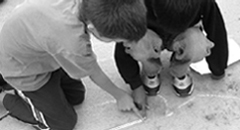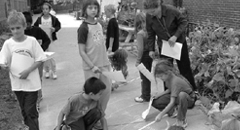
|

|

|
[Allow approximately 1 hour.]
The Modified Collaborative Assessment Conference (MCAC) Protocol is based on the Collaborative Assessment Conference (CAC) developed in 1988 by Steve Seidel and colleagues at Project Zero. The purpose of the protocol is to provide opportunities for teachers to examine and discuss pieces of documentation in a nonjudgmental, structured conversation. This protocol is a bit longer than the Looking at Documentation protocols.
- Getting started. The conference begins with everyone present simply looking at or "reading" the documentation that the presenting teachers have brought.
- Describing the work. The group is asked to describe any noteworthy aspects of the documentation, withholding judgments of quality and comments about taste ("I like" or "I don't like").
- Raising questions. Once everyone has had a chance to describe the work, the group is asked to state any questions that have arisen during the first phase of the conference. The members should be reminded that they may not get answers to all of their questions. What is important is noticing what questions and issues the documentation raises.
- Speculating what the students are working on. At this point, the group is asked to make some guesses—and explain why they have these thoughts—about what the students were working on in this documentation.
- Hearing from the presenting teachers. Having listened for so long, the presenting teachers now add their perspectives on the previous phases of the conference: description, questions raised, and speculation about what the students were working on. They may or may not choose to respond to some of the questions the group has raised.
- Discussing implications for teaching and learning. Everyone is invited to share thoughts provoked by this discussion about teaching and learning and ways to support individual and group learning.
- Reflecting on the protocol. It is helpful to leave time at the end of each conference to reflect more generally on the process. Group members can indicate what is helpful in the protocol and what is frustrating. They can also comment on changes they have noticed in the way the group approaches and uses the structure.
- Thanks! The session should always end with acknowledgment and thanks to the presenting teachers and the facilitator.
Tips for Facilitators
The CAC is an excellent protocol for focusing tightly on one piece of documentation and for practicing skills of observation and description. It is extremely important for the facilitator to encourage participants to refrain from making judgments or assumptions about the documentation. If a participant does make an evaluative comment or one that demonstrates an assumption, the facilitator might ask, "What is it in the work that leads you to say that?"
* This protocol is copied with slight modification from Project Zero et al., Making Teaching Visible: Documenting Individual and Group Learning as Professional Development (Cambridge, MA: Project Zero, 2003), pp.85-86.
© 2006 Making Learning Visible Project at the Harvard Graduate School of Education
[Home] [Site Map]